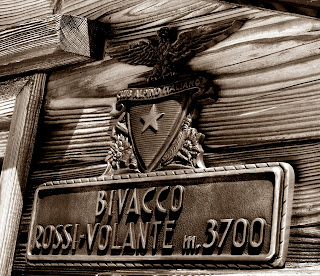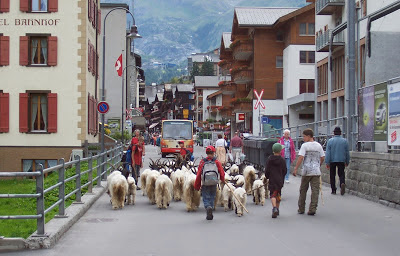 |
| ~ My brother James and Castor in the Swiss Alps ~ |
By early 2007 I was immersed in the culture and history of mountaineering. I had climbed in the Lake District, Snowdonia, and been to Scotland several times. I had climbed Ben Nevis, been winter mountaineering in Glencoe, and stopped off at the Clachaig for a pint after a long day on the hill. In short, I was well on the way to becoming a mountaineer.
But two words challenged and provoked me, kept me awake at night. Those two words were the Alps. I dreamed about gigantic snowy mountains. I read stories of the pioneers, wished I could have been in Zermatt in 1865 when Edward Whymper and his companions set out to climb the Matterhorn. Out there in that vast expanse of ice and cold and searing heat, I felt certain, was where I belonged. I was determined to make it happen.
July 2007
After months of planning, my brother James and I finally made it to Zermatt in the heart of the Swiss Alps. Everything I knew about the town was based on Whymper's classic Scrambles Amongst the Alps; consequently I had expected a small and isolated community, albeit one friendly to tourists with a hotel or two and a train station.
The reality in the early 21st century is quite different. It's a frantic, cosmopolitan place--a clash of cultures and times. Ancient and modern meet in a fascinating blend of the heroic 19th century and the present day. Zermatt has a MacDonalds and every modern convenience you could wish for, and yet all you have to do is slip away from the main street and explore the little alleys and courtyards just away from the centre of the town, and you're back in the 19th century again.
Cars are forbidden here. The hotels operate electric buggies to convey guests from the station to their rooms, although the grander establishments still have horse-drawn carriages.
Zermatt inspired me like no place I had ever been to. Everywhere I walked, I could sense the past just beneath the surface, influencing the present.
Our ultimate objective for the trip was Castor / Il Castore, a huge peak standing at 4,230m above sea level--well above the level of the perpetual snows. It was first climbed in 1861 during the Golden Age of Alpine exploration, although for a modern climber it is not a difficult proposition, being a simple glacier ascent with few specific difficulties. We spent the first week and a half of the trip preparing for this ascent by acclimatising on lower mountains and gradually building up our skills and fitness.
 |
| Lyskamm, Pollux, and Castor (right) from the Breithorn Pass |
 |
| Bivacco Rosse-Volante m. 3700 |
We reached Rossi Volante after a trek of a few hours across the glacier. Neither or us had ever been on a glacier before, and it was quite an experience. Fresh snow had covered any crevasses but nevertheless we roped up in the approved fashion as a safeguard against falling through any hidden snow bridges. Fortunately a well-trodden piste marked the correct way around the back of the Breithorn.
 |
| The author abseiling down to the hut |
Apparently a chain is normally in place to act as an anchor, but it was hidden under the fresh snow. We excavated a 'snow bollard' and took turns to abseil down the slope of 50 degree slush and rubble. I hadn't done too many abseils before and it was all very exciting!
The hut sleeps twelve in squalor, and is furnished with a variety of rotting mattresses and a picnic table (which takes up about a quarter of the room inside). There were holes in the floor and the snow around the hut had obviously been used as a toilet by previous occupants. Fortunately we were the only residents, and we spread our gear around to prepare for the night.
Sleeping is difficult at high altitude. Breathing is rapid, and it's difficult to become relaxed enough to drift off. The sounds of the mountain and the creaking of the hut kept us awake. By the time 3am came round we were glad to get up and get on with the day.
 |
| Collecting ice for the 3am brew |
The sun came up soon enough, and we were treated to the spectacular vision of Alpenglow at dawn. Light burst above the distant Dauphine range and Mont Blanc shone like a new penny on the far horizon. It was a moment of wonder for us both.
 |
| Our first Alpine dawn |
 |
| "Es geht?" |
 |
| Me climbing the last few metres to the ridge |
Breaking out onto the summit ridge of Castor was one of life's most memorable events. I stood on a tightrope of snow the width of a railway sleeper. Behind me lay the vast gulf of the West Face, ahead the even more precipitous drop to the Gornergletscher miles beneath. A panorama of jagged peaks opened up all of a sudden on all sides, a realm of snow rising above the summer green in the valley further below than I would have thought possible. For the first time in my life I stood on a mountain top above 4,000m. It was a defining moment.
 |
| The author on the summit ridge of Castor |
 |
| James trying to coil the frozen rope |
We descended in good time, picked up our gear from the hut, and raced back to Klein Matterhorn in time for the cablecar down to the valley. To say we were pleased with ourselves would be an understatement; we had climbed our first 4,000m peak and lived to tell the tale! I think our expedition to climb Castor is a perfect example of all that is good about mountaineering. It wasn't about technically difficult climbing, it was simply about the sheer enjoyment of getting to the top of an aesthetically stunning peak.
This wasn't the last time we climbed Castor. The next year we returned and climbed it as part of a longer expedition to Lyskamm. On our way to this higher peak we had to climb Castor not only once, on the way there, but also on the way back to the hut! Now that was a big day out...
 |
| Looking back to Castor and Mont Blanc |


No comments:
Post a Comment